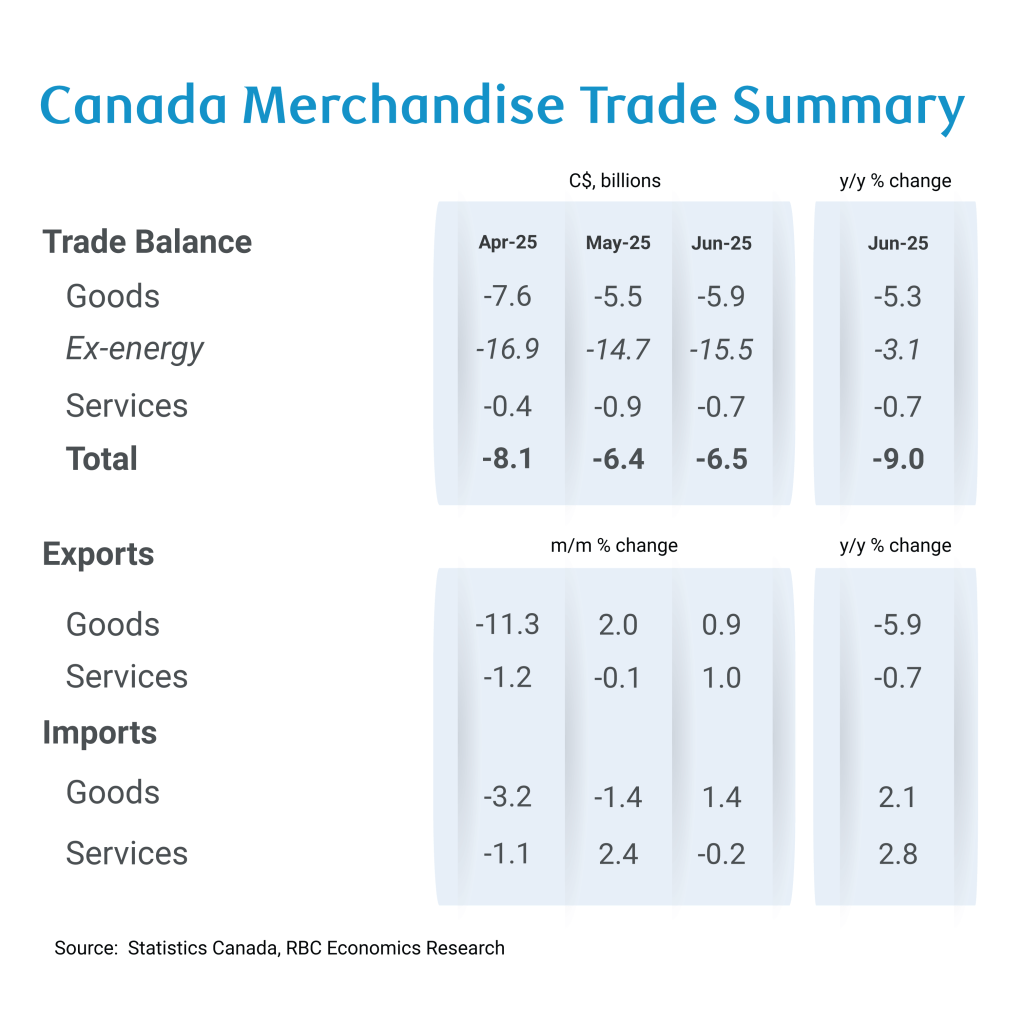The Bottom Line:
Canada’s international trade flows remain depressed in the wake of U.S. tariff hikes, but a narrowing in the deficit in July means the record (outside of the 2020 pandemic) subtraction from GDP from net trade in Q2 will not likely be repeated.
Goods exports were still down almost 5% from a year ago in July, but edged up 0.9% from June — a 5% month over month increase in exports to the United States offset an 8.6% pullback in exports to the rest of the world.
U.S. tariff policy will continue to add volatility and uncertainty to trade flows — and U.S. tariff revenues continued to rise in July, climbing towards a 10% effective rate (calculated duties as a share of U.S. imports.) But, critically for Canada, most of the revenues are not coming from imports from Canada with an exemption from tariffs for most products compliant with the CUSMA free trade deal continuing to hold.
Data from the U.S. Census Bureau showed 88% of Canadian exports to the U.S. continued to cross the border duty free in July. That was down from 92% in June, but still left Canada with the lowest average effective tariff rate (3%) of any major U.S. trading partner.
Sector specific tariffs on U.S. imports from Canada of products like steel and aluminum are still having an impact — Canadian exports to the U.S. of steel and aluminum products targeted with tariffs were down almost 50% from a year ago by our count — but a low relative tariff rate has been helping prevent that sector-specific weakness from spreading more broadly across the economy.
The tick higher in export volumes in July is consistent with Statistics Canada’s preliminary report that manufacturing sales increased in the month, and labour markets have shown signs of stabilization with the unemployment rate edging lower over June/July (6.9%) after rising to 7.0% in May. U.S. trade policy will remain a significant source of uncertainty, but we do not expect the Q2 GDP decline in Canada to be repeated.
The July details:
-
The Canadian goods trade deficit narrowed to $4.9 billion in July from $6.0 billion in June (previously reported as $5.9 billion)
-
Exports edged up another 0.9% in July and are now up 3.0% after plunging 11.2% in April.
-
Imports fell 0.7%, but largely due to a a large “one-time high-value” import of equipment destined for Canada’s offshore oil production sector. That added $2 billion to imports in June but was (as expected) not repeated in July.
-
Excluding that distortion, imports would have increased 2.2% — consistent with a relatively resilient Canadian domestic spending backdrop.
-
Higher imports of motor vehicles and parts (2.2%) and consumer goods (1.6%) are not surprising given resilient consumer spending to-date, but excluding that one-time equipment import distortion, machinery and equipment imports (a key indicator of domestic Canadian business investment spending) also rose almost 5% in July and were essentially unchanged from a year ago excluding price impacts.
-
Most (88%) of Canadian exports continued to cross the U.S. border duty free in July — largely due to a rapid increase in CUSMA compliance since an exemption from tariffs for products compliant with that agreement was instituted in April.

About the Author
Nathan Janzen is an Assistant Chief Economist, leading the macroeconomic analysis group. His focus is on analysis and forecasting macroeconomic developments in Canada and the United States.
This article is intended as general information only and is not to be relied upon as constituting legal, financial or other professional advice. The reader is solely liable for any use of the information contained in this document and Royal Bank of Canada (“RBC”) nor any of its affiliates nor any of their respective directors, officers, employees or agents shall be held responsible for any direct or indirect damages arising from the use of this document by the reader. A professional advisor should be consulted regarding your specific situation. Information presented is believed to be factual and up-to-date but we do not guarantee its accuracy and it should not be regarded as a complete analysis of the subjects discussed. All expressions of opinion reflect the judgment of the authors as of the date of publication and are subject to change. No endorsement of any third parties or their advice, opinions, information, products or services is expressly given or implied by Royal Bank of Canada or any of its affiliates.
This document may contain forward-looking statements within the meaning of certain securities laws, which are subject to RBC’s caution regarding forward-looking statements. ESG (including climate) metrics, data and other information contained on this website are or may be based on assumptions, estimates and judgements. For cautionary statements relating to the information on this website, refer to the “Caution regarding forward-looking statements” and the “Important notice regarding this document” sections in our latest climate report or sustainability report, available at: https://www.rbc.com/community-social-impact/reporting-performance/index.html. Except as required by law, none of RBC nor any of its affiliates undertake to update any information in this document.


